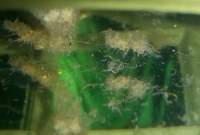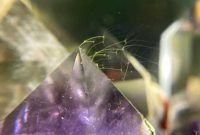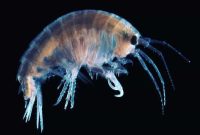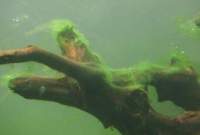Looking at unusual and freaky creatures sticking on the tank glass, appearing without permission, makes us feel upset. Because it could be a parasite that can harm our pets or plants. One little bugger which makes many hobbyists frustrated is planaria flatworms, it can bring many problems inside the aquarium.
The presence of these creatures also can be an indicator water quality of your tank. But they also can be introduced into your tank because of your unrecognized mistakes.
There are many factors that make them come up and thrive well, giving a bad experience for the tank owner in running their hobby.
On this occasion, we serve this content to anyone who has a problem with this ugly pest or needs deeper information about them in order to guard their tank. Let’s begin to read.
TABLE OF CONTENTS
What Is Planaria Flatworms?
Planaria (or planarian as a single form) are a member of flatworm types (turbellaria) that belong to the ancient Platyhelminthes phylum. The creatures under this group are different, and their characters are distinctive.
Turbellaria is distributed to many areas of the world, inhabiting marine, freshwater, and even terrestrial environments.
The planaria name is commonly used for free-living flatworms from the order Tricladida (triclads), but it also represents most number of free-living Platyhelminthes members.
Triclads worms consist of three suborders based on their phylogenetic relationship, including Cavernicola, Continenticola, and Mariacola. Previously, this order was divided according to their habitat, following Paludicola, a freshwater form; Mariocola, a saltwater type; and Terricola, a land-dwelling.
Unfortunately, it is not a new matter if the planaria flatworms can be discovered in tropical or saltwater aquariums and become a horrible thing for most aquarists. Many people believe the terrible overfeeding practice is the common reason why they arise in the tank.

Habitat
These weird worms can live in most areas in freshwater and saltwater conditions such as a lake, rivers, ponds, canals, and other related water bodies that are associated with both environments mentioned before. While the land-dwelling specimens are commonly found in or on the soil, under the logs, or hiding in the plants in humid places.
Appearance
Learning more about your enemy’s face before you go against them is essential. Distinguishing them is pretty easy because their appearance is more conspicuous than other fish tank parasites like hydra or detritus worms.
The planaria are flat worm with a triangle-shaped head. There is a pair of eyes that seems like two tiny spots (also known as ocelli) that are sensitive to the light, while other species have a few of eye-spots. Their eye’s role as photoreceptors can help them move away from the light sources.
On the left and right head sections, there are two auricles (lobus) that extend from every side and contain very sensitive cells. This part can help them to find the food. When the meal is located, they will begin to eat it using the protrusion muscular pharynx.
The food is pumped into their stomach throughout the rhythmic contraction of their muscular pharynx; this process looks like a siphon-like action.
These worms are unique; they do not have lung and circulatory systems. Besides, planaria are an animal with an acoelomate body, meaning they do not have an internal cavity to hold their organs. Instead of the anus, they have flame cells, and it function is to remove the waste. So, if you try to stretch out their body, they might not reach one-inch length.
For your information, they consist of 3 germ layers: endoderm, ectoderm, and mesoderm. Planaria also have one anterior branch and two posterior branches.
These aquarium pests can move from one place to another place by beating their cilia on the ventral vernis; it supports these creatures to slide along on a layer of mucus. On the contrary, some specimens use contractions of their muscles built into the body membrane that creates an undulation effect on the whole body, making them move to other areas.
Their size is very small, generally between 0.1 until 0.6 inches. Planarians vary in colors; they can be brown, white, grey, and pinkish, depending on what they consume.
Types Of Planarian Flatworms That Commonly Seen In Aquarium
However, there are many types of these worms living on earth; in fact, only two types that often appear in the planted tanks. That is black and brown planaria (dugesia) and white planaria (procotyla).
A truth that makes them permanently banned by many fish tank keepers is they are carnivorous. They are consuming dead or live animals attached to their bodies and suffering them. And if the owner does not treat them immediately, their victims’ chances can survive are impossible.
Well, there is no difference between these two types of planaria for the aquarists.
On the other hand, these worms are frequently seen gliding on the wall glass rather than settling in the substrate, such as other fish tank bugs like scuds.
Dugesia
They are brown and black planaria worms type. Dugesia known does not too dangerous for fish; their main diet is detritus like leftover food, feces, and biofilms.
If you found these flatworms type inside your aquarium, that indicates poor tank husbandry. And if you leave your tank to become dirtier, their numbers potentially might reach more than a hundred or even thousands.
In spite of the fact that they can not damage, dugesia worms can glide into fish’s gills or other sensitive organs. It can cause your fish to be stressed, dropping their immune system and making the victims vulnerable to illness.
However, they will lead to a disaster if you keep some shrimps in your tank setup. Dugesia supposed can release a poison that can toxins invertebrates. Well, if a single worm creeps inside a shrimp’s carapace, the toxins can be stored in the shrimp’s tissues, then cause a severe problem.
Procotyla Fluvitalis
This flatworm is described as white planarian. Procotyla is absolutely a predator, hunting daphnia, crustacea, other small worms, and even other planaria.
This worm will strike any tiny organisms they can reach, such as shrimp babies, fish fry, shrimp and fish eggs, or even adult shrimps.
The white planarian tends to happen in a small population than dugesia, but the inflict of their damage can be brooke most of your peaceful shrimps.

Planaria Flatworms Reproduction
According to many sources on the internet, these worms can produce themselves in two ways, sexual and asexual or usually called hermaphrodite.
The sexual method occurs when two planarians are mating up and fertilizing each other’s eggs (each planarian possesses both ovaries and testicles). Eggs develop inside their bodies, then shed in a capsule or cocoon.
Their eggs split into types of eggs depending on the temperature, that is winter eggs (black color) and summer eggs (translucent and thin-shelled).
Summer eggs require a couple of weeks to hatch, which is shorter than other ones. In nature, the winter egg incubation periods may happen throughout this season. Once they are hatch, the embryo has an appearance similar to the mature version.
In hermaphrodites, planarians generate themselves by detaching their tail end. After that, each half will regrow the missing parts by regeneration, allowing the adult stem cells (endoblasts) to split and differentiate, then outcoming two planarian worms.
Planaria worms are famous as one of the undying creatures in the world. Based on scientific research, these creatures just require 1/279 parts of their body to restore their full body. And finally, it only needs two weeks to regenerate everything.
What Causes Planaria Flatworms To Arise Inside Aquarium?
Actually, there are many ways that can make these little worms present inside your beloved living tank, and here is:
- The first is overfeeding, which is still the main reason for most aquarium problems; of course, planarians also result from this point.
- When you introduce new plants, equipment, water from the fish bag, snails, shrimps, crabs, live foods, stones, driftwood, fish, substrate, or other decorations from other sources that contaminate by these pests. They may ride on it and reproducing themselves rapidly, spreading to all corners of your tank.
- And the last is not systematic maintenance; this point heard a that means nothing, but you do not underestimate it. It can drive an imbalance inside the aquarium, making it more vulnerable to affect by some issues, including these worms.
Are Planaria Flatworms Harmful For Your Pets?
As mentioned above, these flatworms can hurt your pets in the aquarium, primarily the smallest and weak animals such as shrimp and snail babies, also their eggs. Even more, the mature species can not escape too from them, if the food sources are minor.
Their infestation certainly does not bring immediate mass destruction to the whole stock. This is like the younger only had a little chance to reach maturity, and old ones will over-age, and in the end, the population declines over time.
Surely, fish are not threatened by their presence, and a few species are helpful to wipe off the planarian.
The carnivorous fish will predate these flatworms to become their wild enemies inside the aquarium and control their numbers.
Although the fish fries and eggs are probably not fully secure from the planaria, they could be chased quietly and unnoticed by the parents.
What Are Planarian Flatworms Can Injure The Aquarium Plants?
Unlike other plagues such as ramshorn snails outbreak, it can destroy the vegetation and water quality. As mentioned before, if they are pure carnivores.
So the aquatic plants are not listed on their target, meaning the planarian would not eat your plants. Well, do not feel worried about that, even if your planted tank invades by these nuisance animals.
How To Get Rid Of The Planarian Flatworms In My Aquarium
Simply, you can remove them manually, but are you sure willing to pick them out from the fish tank all day one by one? That is really a waste of your time; even if their population decreases, their numbers are back several days later.
So, in this chapter, we will tell two remedies methods against the planarian that uses by most aquarists; let’s read:
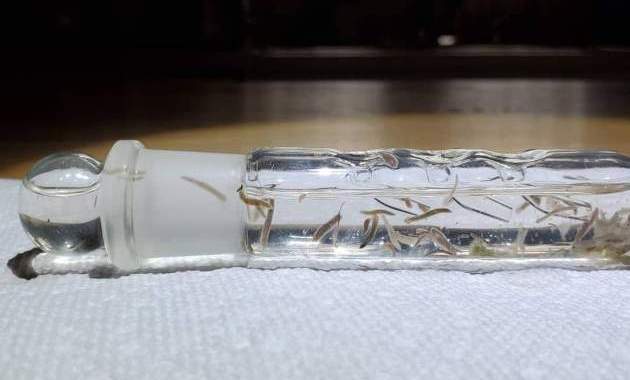
Planarian Traps Method
Obviously, you can find this product easily on the internet, just typing ‘Planarian Traps’, and the result shows. We advised purchasing this product on Amazon or local aquarium stores.
However, it would be better if you make this one, no need much money and time to cost. Here are the steps:
- Prepare a 500 ml plastic bottle or any size that fits your tank.
- Seize a needle, then create several very small holes at the bottom side. You can poke as much as you want, but ideally, four or five holes are enough.
- Add 2 or 3 different types of food in small portions into the bottle. They prefer shrimp meat or fish flakes. Ensure do not put too much; it can promote ammonia to blow up.
- Close the bottle cap and squeeze it to push out the air while submerging it into the water in an upside-down position. Let the water totally replace the air to avoid it floating.
- Press the bottle softly until the bottom part slightly enters a tiny bit of substrate; after that, leave it in this position for 2-12 hours.
- Repeat this process daily until you feel satisfied and do not catch anything.
- Ideally, you need to cycle that about 3-4 times.
- Clean the bottle completely and save it for the next time you get a similar problem.
- After 2-3 weeks, perform this process to eliminate the planaria hatched from the eggs. It aims to prevent a second invasion.
Basically, this bottle’s work is very identical to conventional planaria trap’s work. Another alternative trap is using a gauze bag. Put a fish flake, beef meat, squid cutlet, etc., inside the bag. Locate this bag at the substrate around the plants for one night. Switch off the aquarium lamp in order to gain more worms. When the morning comes, please take out the bag carefully (without turning on the light), then lay it in boiling water.
Chemical Products Treatment
Fighting with planaria in this way is suitable for med-high outbreak levels. Many famous products that chosen by hobbyists a long time ago, and below is the list:
SOBAKEN Genchem No-Planaria
No-Planaria is one of the most famous planaria killer’s medicine. It is made from betel nut palm extract, which means it is an herbal treatment, making it safe for plants and shrimps. Be aware that it might hurt your snails or even kill them; always read the procedure.
How to use this natural medicine:
- Move all snails to a separate tank, and quarantine them in there in order to kill planarian worms or their eggs that cling to them.
- Detach the carbon media in the filter system to raise the effectiveness.
- Installing an air pump to increase the oxygen level.
- Add one spoon of this medicine to 13 gallons (50 liters) of water on the first day.
- On the second day, cut off the dose to 1/2 spoon. And the third day, reduce the amount again to 1/4 spoon.
- Do a water change of about 40-50 % on the fourth day.
- Apply the carbon media to its place back.
- Perform a 20 % water change after seven days.
- Once these pests are dead, take a siphoning kit or tablespoon to remove them from the tank to prevent the ammonia substance go up.
- Use a test kit to monitor the water parameter; if there is an imbalance, fix it.
- You might perform this series of treatments 2-3 weeks later in order to eradicate these worms that hatched from the eggs.
- It probably needs a little time until the planarian dies.
- You should not give your shrimp some food in the first days of treatment; it aims to block further contamination.
Benibachi Planaria Zero
This dewormer or worm killer also uses a betel nut extract as its major ingredient. The ‘Planaria Zero‘ also can use to conquer other aquarium parasites such as hydra.
- Like the previous product, the first step is moving the snails to the quarantine tank.
- Remove the carbon media from the filter.
- Apply an air pump to gain the O2 content.
- On the first day, add two spoons or 1 g dose for 13 gallons (50 liters) of water. Use the same dose for the second day, while on the third day, minimize the dose to 0.5 g or one spoon for 13 gallon / 50-liter water.
- Reduce the aquarium water by around 20 % and return the carbon media to its place.
- If you still found some planarian left, give one spoon of ‘Planaria Zero’ for 50 liters of water at the ten-day.
- Do water change again in 11 days for around 20 %.
- Take up the dead planarian flatworms inside the aquarium immediately before they contaminate the water quality.
- Use the water test kit to check the quality.
- Maybe you should do this medication after 2-3 weeks later in order to kill new flatworms that hatching from their remaining eggs in the aquarium.
- Unfeed your pets during the first three days are suggested to boost the success chance and avoid further contamination.
Panacur C Canin Dewormer (Fenbendazole)
The Panacur (Check on Amazon for detail) is actually produced does not for aquarium use. So, it’s hard to find a correct dose rate on the internet because the information that was they write is an assumption of that particular person when against these flatworms in their aquarium.
However, we summarized information from some aquarists’ experiences that successfully countered these worms using this cure.
- Moving your snails into the quarantine tank.
- Adding two to four mg Panacur dose per 1 gallon.
- Performing water change around 30-50 % after seven days.
- Spoon out the dead planarian to keep your tank stable.
- After three weeks, repeat this treatment to kill worms from the eggs that survive from the treatment.
Many aquarium keepers give positive reviews to Panacur, which helps them resolve their problems. This worm killer is available in two types, liquid and pill.
If you bought a pill-formed, it might be difficult to dissolve well into the water. The solution is to take a test tube or bottle, place it on there, crush the dose of Panacur and mix it with some aquarium water. After that, shake this mixture, and it is ready to use as mentioned before.
Canine Dewormer Safe-Guard
Same with the Panacur, this product is not specifically for aquariums but especially for dog remedies. Canine Dewormer (check on amazon for details) contains a material that can treat intestinal parasites or commonly call as Fenbendazole.
This dog dewormer works greatly and gets many good reviews from many aquarists because proven could exterminate planaria flatworms inside their freshwater aquarium. How to use it:
- Move all snails into a separate tank.
- Use 0.1 g per 10 gallons of water (45 liters) and wait for around 48 until 72 hours.
- Add 0.1 g for 10 gallons of water, then leave for 48-72 hours.
- If there are some planaria still alive, give a dose like before.
- After you see planarians are dead, take them out of the aquarium.
- On the next day, perform a water change of around 20%
- Do 20 % water change again.
- Perform 20 % water change again.
- After two to three weeks, repeat this medication to remove new worms that hatched from the surviving eggs.
How To Prevent Planaria Flatworms Invasion Your Aquarium
In order to keep away your tank from this plague, you should follow this step below:
- The first step is keeping some predators fish that can control the planarian population like betta, mollies, guppies, zebra loach, angelfish, tiger barbs, goldfish, springers damsel, red-spotted gobby, dwarf gourami, samurai gourami, licorice gourami, three spot gourami, chocolate gourami, pearl gourami, sparkling gourami, honey gourami, pea puffer, and more.
- Give sufficient food. Always keep in your mind to never overfeed your inhabitants, the accumulation of the leftover food will be ended in the worst tragedy.
- Clean your aquarium systematically and periodically.
- Always quarantine anything before you put it inside the tank, such as plants, fish, snails, shrimps, driftwood, old equipment, and decorations from other sources. If you decide to use soil, gravel, or sand from the garden, you should clean, wash up, and boil it. This rule should also be applied to any decorations taken from nature.
- Lastly, ensure to wash your hands before contacting anything associated with your aquarium.


